Beaches on the island of Zakynthos
The Greek island of Zakynthos is famous for its beautiful beaches and with 123 km of coastline, there is certainly one for everyone. The beaches of Zakynthos are mostly sandy, which is not the norm in Greece, but there are also pebble to rocky beaches. The Ionian Sea off the coast of Zakynthos stands out for its clarity and dazzling azure blue colour. A number of beaches have also been awarded the EU Blue Flag for their cleanliness and beach facilities.
The symbol of Zakynthos has become Navagio Beach with its smuggler's shipwreck, which is particularly beautiful for its contrast of bright high cliffs, tiny white pebbles and the turquoise waters of the Ionian Sea. Among the busiest tourist spots are the beaches of Laganas Bay, led by the largest beach, Laganas.

Agios Nikolaos (Vassilikos)
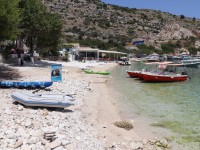
Agios Nikolaos (Volimes)
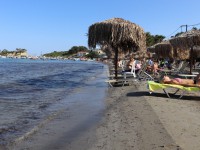
Agios Sostis
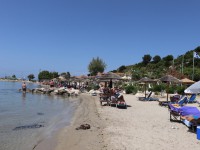
Alykanas (Alikanas)
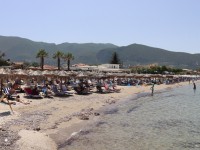
Alykes (Alikes)
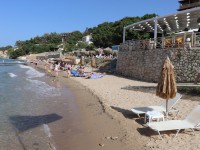
Amboula
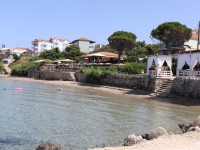
Ammoudi
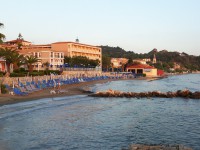
Argassi
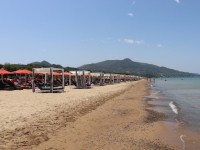
Banana
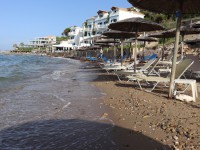
Bouka
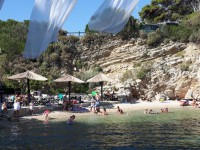
Cameo
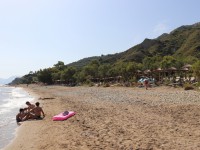
Dafni
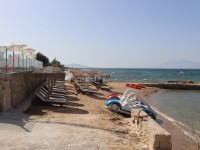
Drosia
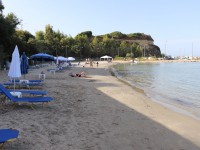
Gaidaros
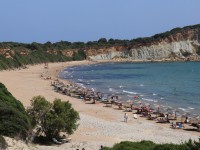
Gerakas
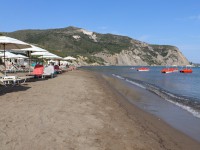
Kalamaki
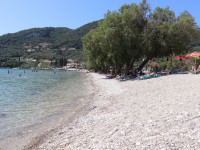
Keri
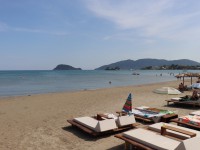
Laganas
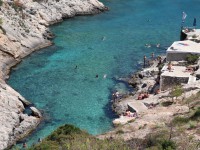
Limnionas (Porto Limnionas)
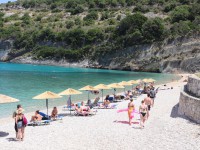
Makris Gialos
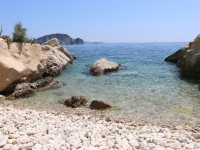
Marathia
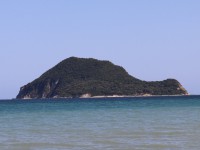
Marathonisi
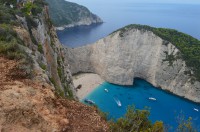
Navagio (Shipwreck Beach)
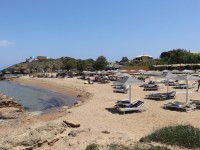
Plaka
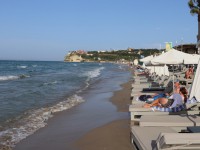
Planos
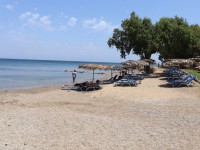
Porto Kaminia
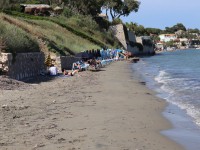
Porto Koukla
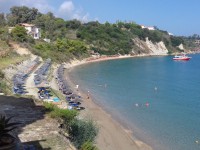
Porto Roma
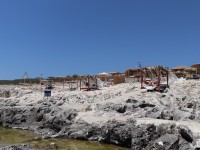
Porto Roxa
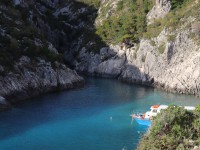
Porto Stenitis
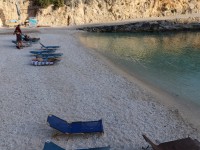
Porto Vromi
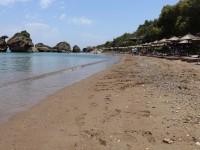
Porto Zoro
Porto Zorro, Porto Azzuro
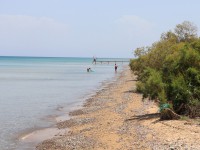
Spanzia
Spianza, Spiantza
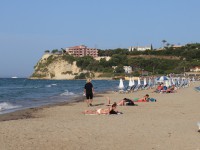
Tsilivi
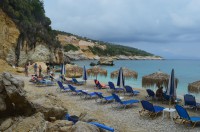
Xigia
Xygia Sulphur
Diverse coastline of Zakynthos
Zakynthos is one of the sunniest Greek islands and the summer season is really warm and sunny, ideal for exploring the beauty of the diverse coastline of Zakynthos. In terms of the nature of the different beaches, the island's coastline can be divided into several sections.
Generally speaking, the beaches on the southern coast (Laganas Bay) and on the eastern side of the island are mostly organised, sandy to sandy-pebbly and with a more gradual entry into the sea. The most popular holiday resorts are also located here, and most beaches have good tourist facilities in the form of sunbeds and umbrellas, showers, toilets, and often tavernas, beach bars and water sports centres. In addition, Laganas Bay has a special regime aimed at protecting its unique nature and in particular the endangered Caretta Caretta sea turtle.
The coastline on the west side of the island is very rocky, which is reflected in the character of the beaches. The bays and beaches are often bordered by steep cliffs, rocks and beautiful sea caves, which make the beautiful colour and crystal clarity of the sea stand out. The beaches lie away from the busy holiday resorts and are often natural and unorganised, although there are some beaches where you can use sunbeds or hire a boat, for example.
The most popular beaches of Zakynthos are definitely the famous Navagio beach, Porto Azzuro beach with its golden sand, the beautiful Gerakas beach, which is also popular among families with children, Banana beach covered with the finest warm sand, Tsilivi beach with the most beautiful sunsets, Porto Limnionas beach as a tip for unusual swimming for adults or the busiest beach with bars Laganas and many others.
South coast - Laganas bay
The southern coast of Zakynthos is one of the most popular tourist areas of the island , consisting of the large sandy bay of Laganas, with a gradual entrance to the sea. The famous holiday resorts are located here , the beaches are very popular and tend to be crowded in the peak summer season. The adjacent tourist resorts and the beaches themselves offer visitors a very good service, and the beaches in Laganas Bay are organised, equipped with sunbeds and umbrellas, sanitary facilities, often also beach bars, tavernas and a variety of water sports. Laganas Bay is unique in that it is dedicated to sea turtles and their conservation, hence its nickname 'Turtle Bay'.
Laganas Bay, including the islets of Marathonisi and Pelouso, forms part of the Zakynthos National Marine Park, which aims to protect the local nature and in particular the endangered species of giant duck (Caretta caretta) and the Mediterranean monk seal (Monachus monachus). In Laganas Bay there are six beaches with a total length of over 5 km, which are used by the ducks for nesting (laying their eggs in the sand) - Marathonisi, Laganas, Kalamaki, Sekania, Dafni and Gerakas. Sekania beach, with the highest density of turtle nests, falls under an area of absolute protection and is not open to the public. The remaining beaches are designated as natural protected areas where special measures are in place to protect the sea turtle population.
Popular beaches on the southern coast of Zakynthos, arranged from west to east:
Keri Beach (Limni Keri) - The beautiful pebble beach of Limni Keri overlooks the small "turtle" island of Marathonisi, with mature trees providing pleasant shade for visitors. The beach is organized with sunbeds and umbrellas, beach bars and tavernas, there is also a small marina and a diving club.
Porto Koukla Beach - The narrower sandy beach of Porto Koukla, with its shallow, heated waters, offers visitors plenty of sunbeds and umbrellas and, above all, peace and relaxation. The beach is surrounded by mature trees and there are also tavernas, bars and restaurants close to the beach. Porto Koukla Beach also boasts a spectacular view of the sunset and the nearby islet of Marathonisi.
Agios Sostis Beach - Agios Sostis follows the narrower Porto Koukla Beach and then moves on to the popular wide Laganas Beach. Agios Sostis beach is a smaller sandy beach with a gentle entrance to the sea and a beautiful view of the island of Cameo.
Cameo Beach - The islet of Cameo lies just off the coast and can even be reached on foot, as it is connected to the mainland by a narrow wooden bridge. On the far side of the islet is the white pebble beach of Cameo, with a bar and seating area and a second bar up on the cliff with a beautiful view of the surrounding area. Cameo Island is very photogenic and makes for some really beautiful photographs, which is why it is often chosen by engaged couples as the location for their wedding ceremony.
Laganas Beach - Laganas Beach is a beautiful long sandy beach, the largest on Zakynthos and very popular with tourists (regularly crowded in the peak summer season). The beach with its golden sand, azure sea and gradual entry into the water also has excellent tourist facilities. In addition to sunbeds and umbrellas for rent, a number of beach bars and taverns offer a wide range of water adrenaline sports and evening life in the local party clubs. At the same time, Laganas Beach forms part of a protected area where the endangered Caretta-Caretta turtles come to lay their eggs. Right on the beach you can see the hatchlings of the protected caretta turtles, usually marked with a wooden tripod with a sign. So you have to respect the rules (usually posted right by the beach).
Kalamaki Beach - A sandy beach with a shallow seabed is ideal for families with small children. It's close to one of the busiest resorts in Laganas, but it's quieter than Laganas Beach itself, has a few sunbeds and umbrellas, and offers plenty of open space. The beach is surrounded by rocky hills covered with greenery. Kalamaki Beach also serves as a nesting site for Caretta sea turtles.
Dafni Beach - Dafni Beach is located in the more secluded part of Laganas Bay, on the southeastern tip of the island. Dafni is a quiet beach with a few sun loungers, a sandy shoreline and clear waters. Thanks to the beautiful seabed and the Caretta-Caretta turtles that inhabit the area, the left side of the beach in particular is ideal for snorkelling.
Gerakas Beach - A beautiful sandy beach with several sun loungers, clear water and a gradual entrance to the sea, protected by interesting rock formations covered with green vegetation. The beach serves as a natural habitat for Caretta sea turtles and is also included in the so-called Zakynthos National Park.
Marathonisi Beach - The small island of Marathonisi, located in the bay of Laganas, is also part of the protection zone of the National Marine Park of Zakynthos and is nicknamed "turtle island" due to its shape. Marathonisi is the only island in the marine park open to the public, and those interested can also relax on the beautiful sandy beach of Marathonisi, but with great care as there are many turtle nests.
Southeastern and eastern coast of Zakynthos
The eastern coast of Zakynthos is the most diverse of the island. While the south-eastern coast and the central part of the eastern coast (from the resort of Vassilikos, through the capital of Zakynthos to the holiday resort of Alykes) are dominated by sandy beaches, such as the popular Banana Beach, Tsilivi or the long beaches of Alykes and Alykanas, the northern part of the eastern coast is more dominated by pebble beaches and beautiful rocky coves. The beaches in the south and central part of the east coast are generally organised, equipped with sunbeds and umbrellas, tavernas or beach bars and often water sports centres. For example, Banana Beach and Agios Nikolaos are among the best tourist beaches in Zakynthos.
Popular beaches on the east coast of Zakynthos, arranged from south to north:
Porto Roma Beach - Beautiful, sandy beach with crystal clear water and surrounded by greenery. Porto Roma Beach has tourist facilities in the form of sunbeds and several beach restaurants, but still retains its peaceful atmosphere.
Agios Nikolaos Beach (San Nicholas / Vassilikos) - A very popular beach located on the southeastern coast of the island and named after a small chapel on the shore. Agios Nikolaos is a sandy beach, well organised, including water sports facilities.
Banana Beach - Banana Beach is a large beach with fine golden sand and turquoise sea, popular not only with families with children, but with all those who want to relax, sunbathe and swim in the azure sea. It is very well organised, with plenty of sunbeds and umbrellas, several beach bars and a range of water sports. Thanks to the wide range of water adrenaline experiences, the younger generation in particular comes here, and there is also a bus stop above the beach.
Porto Zoro Beach (Porto Azzuro) - The surface of Porto Zoro Beach is made up of coarse sand to pebbles and there are larger rocks and rock formations in the sea in one part, so caution is advised. However, the entrance to the sea is gradual and comfortable, and beachgoers can make use of the sun loungers for hire and the beach bar. The natural shade of the surrounding trees is also pleasant.
Argassi Beach - The beautiful smaller beach of Argassi, with its golden sands and wide range of sports facilities, is part of the popular holiday resort of the same name. Near the beach, at the mouth of the river, is the famous Argassi Bridge, now partially submerged in the sea.
Tsilivi Beach - The beautiful sandy and well-organised Tsilivi beach lies north of the capital Zante and is very popular with tourists. Due to its clean sea and its facilities, it is also regularly awarded the Blue Flag, and families with younger children also seek it out due to its gradual entry into the sea. Visitors can find a number of sunbeds, several beach bars and taverns, a water sports centre and a diving club, and the Tsilivi Waterpark with its many water attractions is also nearby.
Amboula Beach - The small sandy beach of Amboula is one of the most peaceful beaches, the sea floor is rocky with pebbles of various sizes and the sea is crystal clear. The beach is equipped with sunbeds, but for the most part remains natural.
Alykanas and Alykes beaches - A long stretch of fine light sand with calm, crystal clear water covers the two beautiful and popular beaches of Alykanas and Alykes, one flowing seamlessly into the other. The beaches are adjacent to busy beach resorts and are well equipped, including beach tavernas and water sports equipment rental.
Northeast coast of Zakynthos
The northern part of the eastern coast is different in type, with more pebbles, stones and rocky hills. There is also a noticeable difference in terms of tourism, as the larger and more lively tourist resorts end with the resorts of Alykes and Alykanas and there are no more major holiday resorts further north. For example, only the small village of Agios Nikolaos is better known, thanks to its harbour from which various boats, boats and ferries leave daily for the neighbouring island of Kefalonia. On the northeast coast there are beautiful rocky coves such as Xigia Beach or Makris Gialos, and beautiful blue caves known for their play of colours and the glare of the sun's rays.
Popular beaches on the eastern coast of Zakynthos, arranged from the middle to the north:
Xigia Pigadi beaches - The narrow pebble beach of Xigia Pigadi is located in the more remote part of the island, on its northwest coast. It is a touristy, semi-organised beach with beautiful surroundings and turquoise coloured sea, which, thanks to sulphur springs, takes on a slightly milky tinge.
Pelagaki beach - North across the rocky outcrop lies Pelagaki beach, which is similar in type to Pigadi beach, but is unorganised and almost empty due to poorer access on the rocky slope. Yet it is a beautiful beach with white pebbles and crystal clear water, lightly coloured by sulphur springs.
Xigia Sulphur Beach - The pebbly bay of Xigia Sulphur is the northernmost of all Xigia's beaches and the concentration of sulphur springs is highest here, which is evident both in the milky coloured water and, in some places, in the typical sulphur odour emanating from the sea. The place is called "natural sulphur bath" and is the most famous of the Zakynthos sulphur beaches. The beach is partly organized, and in the main summer season there is a light refreshment service.
Makris Gialos Beach - The pleasant, smaller Makris Gialos beach is covered with coarse sand to pebbles and washed by azure clear sea. Visitors to the beach can make use of several sunbeds with umbrellas. The beach has beautiful caves that attract snorkelling enthusiasts, and those interested can also use the services of the local diving centre.
Agios Nikolaos Beach (Volimes) - A smaller beach covered with coarse sand and pebbles is located at the northern tip of Zakynthos, near the mountain village of Volimes. It is famous for the port of Agios Nikolaos, from which cruise ships and ferries regularly depart for the neighbouring island of Kefalonia. There are two Agios Nikolaos beaches on Zakynthos, both quite famous, so beware of confusion.
West coast of Zakynthos
The west coast of Zakynthos is the most natural of the island , very rocky and often difficult to access. Many of its beautiful bays and fjords are only accessible from the sea, so human intervention in these places is minimal and only rarely do we come across at least a partially organized beach. The sea washing the rocky west coast takes on a stunning colour and the views of sunsets from this part of the island are breathtaking.
The west coast of the island is very quiet in terms of tourism, as the most famous and busiest holiday resorts are on the south and east coasts. There are only smaller quiet villages near the west coast.
Popular beaches on the western coast of Zakynthos, arranged from north to south:
Iconic Navagio Beach - The most famous beach of the island is Navagio Beach ("Shipwreck Beach") with the wreck of a smuggler's ship, which most visitors must not miss during their trips around the island. The bay with the beach is located on the northwest coast of the island, the most remote part of the island. The only way to see the shipwreck up close and to sink your feet into the white pebbles here was to take a cruise ship or boat here. Unfortunately, since 2023, due to the threat of rockslides, access to the beach has been banned and tourists can only get within 40 m of the beach. However, the beautiful bay can also be observed from above, from the limestone cliffs.
Porto Vromi Beach - The rocky bay of Porto Vromi with crystal clear water, ideal for snorkelling and observing the beauty of the local underwater world. Visitors to the beach can enjoy refreshments at the beach bar and use the local boat rental service. The rental companies offer boats and dinghies for hire as well as boat trips to the nearby "smuggler's" bay of Navagio.
Porto Stenitis Beach - Very similar in type, but unorganized, the rocky cove of Porto Stenitis lies south of Porto Vromi. The beautiful, almost untouched bay with caves and cliffs dropping into the depths of the crystal clear sea attracts lovers of diving and snorkelling. In reality, there is no beach, just a rough access road and then rocky areas. A better access to the bay is from the sea by boat.
Porto Limnionas Beach - Porto Limnionas is a secluded, rocky cove, ideal for diving and snorkelling due to the beautiful contrasts of the light rocks and crystal clear water. The bay is quite large and surrounded by massive rocks, with a small number of sunbeds available for visitors, otherwise the bay is purely natural.
Porto Roxa Beach - Porto Roxa's partially organized, rocky beach attracts visitors with its perfectly clear sea, spectacular sunset views and nearby cave formations. Steps have been built in the adjacent bay to improve access to the sea, but there is also a bridge for those who want to jump into the deep waters from a height.
Best snorkelling spots on Zakynthos
The Greek island of Zakynthos is a popular destination among snorkelling and diving enthusiasts, as it is bathed in the crystal clear waters of the Ionian Sea and is very rich in sea caves, rock arches and reefs, including a variety of underwater life. The island of Zakynthos is also known as home to endangered animal species, notably the sea turtle Caretta Caretta and the Mediterranean monk seal Monachus Monachus. While snorkelling, these animals can also be seen, but various urchins and reef fish are commonly found here .
The most popular snorkelling spots on Zakynthos are often only accessible from the sea by boat, as access to them by land is very difficult, often steep and rocky. However, some places can also be visited by car.
In general, the west coast of the island is more suitable for snorkelling and diving, as it is more rocky and rich in various coves and reefs. A popular snorkelling spot is certainly Navagio Bay, which has become a symbol of the whole island of Zakynthos. A beautiful bay with high white cliffs, a beach covered with small white pebbles and crystal clear sea. Unfortunately, the beach itself is currently off-limits because of the risk of erosion and landslides of the surrounding rocks. However, snorkelling can still be enjoyed at a distance from the beach.
For snorkelling enthusiasts, we would also recommend Porto Limnionas Bay, which is relatively narrow, but deep thanks to the surrounding reefs and above all boasts amazing visibility in the sea. In the very similar bay of Porto Roxa, there is also a jump into the water from a few metres high.
Off the south-west coast is the small village of Agalas, from which a path leads down to the coast and the small beach of Plakaki. Plakaki is a stunning rocky bay that offers several headlands and cliffs and the sea is crystal clear to a depth of several metres. An ideal place for snorkelling. The view from the top of the rocks is also beautiful, but the way down is steep and full of rocks.
For viewing the underwater world, we can also recommend the Korakonisi rock outcrop off the west coast or the Keri caves off the southwestern tip of the island.
A popular place for snorkelling is the so-called Blue Caves, a well-known attraction of Zakynthos, located off the north coast of the island and frequented by boat trips. The name "blue" was given to these caves because of the reflection of the crystal clear water on the bright walls inside the caves.
The "turtle" island of Marathonisi is located in the lagoon bay in the south of Zakynthos and is known as the nesting ground of the giant duck. There is also a small beach here, but in the high summer season it is full of wooden tripods used to protect the turtle nests. However, swimmers can relax on the beach and explore the whole island with a snorkel.
Zakynthos island and average sea temperature
The Greek island of Zakynthos lies in the central Mediterranean and is bathed in the crystal clear waters of the Ionian Sea. The sea is at its coldest in spring, when the average temperature is around 15 °C. During the months of April and May, the sea begins to warm up and in June, when Zakynthos is already a busy tourist destination, the average sea temperature is a pleasant 22 to 24 °C. The sea reaches its highest temperatures during the peak summer season in July and August, with beautiful average temperatures of up to 27 °C, and still maintains very pleasant temperatures at the beginning of September, which then drop to around 20 to 23 °C during September and October.
The Ionian Sea is the deepest point in the entire Mediterranean, which also has an effect on the temperatures of the waters around Zakynthos. Although Zakynthos is one of the very sunny Greek islands, you cannot expect sea temperatures like those on the popular and warm island of Rhodes. However, the sea around Zakynthos is beautifully clear and in the high summer season its temperature is very pleasant for swimming.
Differences in sea temperatures can also vary between different areas of Zakynthos. The warmest waters tend to be in Laganas Bay and off the south-east coast of the island, where sandy beaches with a gentle entry into the sea predominate. On the other hand, the northern and western coasts of the island are usually cooler.
Map of Zakynthos island - beaches
The various beaches of Zakynthos - sandy, pebbly, rocky, famous and less famous - are clearly marked on the map of Zakynthos.
